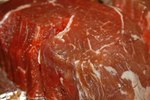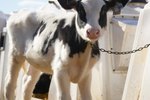
All across the country, young people involved in 4-H livestock clubs or FFA --formerly the Future Farmers of America -- prepare club calves for a season of showing. Club calfs aren't any particular breed. Many of them aren't purebreds, but crosses between two different breeds. They're all high-quality animals, judged on appearance, conformation and carcass weight.
Club Calves
Preparing and showing a club calf means a young person learns to feed, care for and show an animal intended for beef production. Shows are held in spring and summer, often after school is out. They include divisions for heifers and steers, with classes including showmanship, which focus on handling and appearance.
Purchasing
Many cattle breeders specialize in producing club calves for the youth show market. You can find competitive club calves through private breeders, at auctions and through consignment sales. You'll usually purchase a calf between the age of 3 and 6 months. There's a lot of competition in the show ring, so decide whether you plan to compete on a local, regional or national level. Calves suitable for each level of showing are priced accordingly. The 4-H Market Steer Handbook recommends selecting "a well-balanced, stylish calf that is upheaded and alert," as these qualities are important in the show ring.
Feeding
Feeding a club calf is a bit different from feeding a calf that you don't intend to show. The University of Florida recommends starting a calf on free-choice quality hay, approximately 15 pounds per day for a 500-pound animal. Introduce grain roughly three days after getting your calf home. Start with 2 pounds of grain daily, increasing the amount incrementally over the next two weeks so the calf consumes between 6 and 8 pounds daily. At that point, grain and hay should make up an equal 50 percent of the daily feed intake. You can then transition the calf to a growth grain ration, so he becomes more muscular and larger without turning fat. After roughly four months, transition the calf to a finishing grain diet, prior to show season. By that point, the calf's diet consists of 80 percent finishing grain and 20 percent hay daily. Your calf must reach a minimum weight in order to show.
Training
In order to get your club calf ready for the spotlight and judging, you'll need to teach him basic manners. Halter-break your calf early, and teach him to tie and lead. Tying and leading can't be rushed, so take it slow and do it correctly. Once he's got that down, get him used to the livestock trailer, so that he loads and unloads easily.
Grooming
Use your tying sessions to groom your calf before show season. You should clip your calf about once a month. Keep your calves separate from other livestock. Once show season starts, keeping your calf spotless starts in earnest. Show Steers Utah recommends washing and blowing dry your calf daily once summer rolls around. Use shampoo weekly, but condition the hair every day. You must comb your calf in appropriate directions, then blow it dry. Grooming a club calf is an art. Your club adviser can give you tips and recommend products for giving the animal that professional look.
References
Photo Credits
-
Jupiterimages/Photos.com/Getty Images
Writer Bio
Jane Meggitt has been a writer for more than 20 years. In addition to reporting for a major newspaper chain, she has been published in "Horse News," "Suburban Classic," "Hoof Beats," "Equine Journal" and other publications. She has a Bachelor of Arts in English from New York University and an Associate of Arts from the American Academy of Dramatics Arts, New York City.



